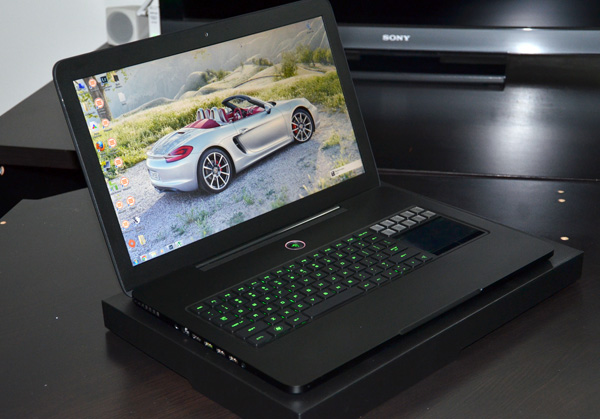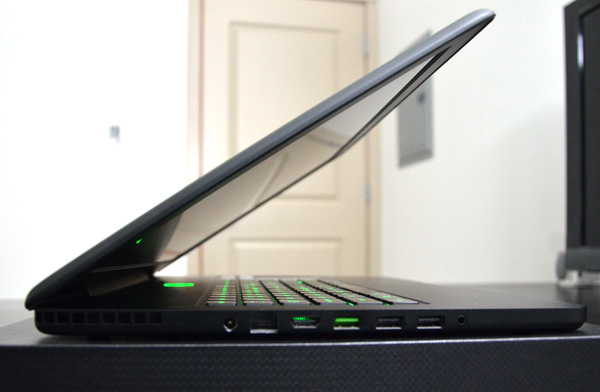The Razer Blade Review
by Vivek Gowri & Jarred Walton on March 15, 2012 3:01 AM ESTThere is something absolutely arresting about the Blade’s overall aesthetic. It’s big, but so strikingly thin at the same time, and the matte black paintjob is like a visual black hole. The overall effect is eye-catching, breathtaking, and will cause random passerby to stop and ask questions.
The design language is really, really clean and rather understated, two things you don’t expect from most gaming notebooks, while still keeping a sense of flair about it. The lid has two ribs vertically arranged on either side of the glowing Razer logo on the back, breaking up the monotony of the otherwise flat profile of the lid. Everything here is very uniformly laid out—lots of rectangles with radiused edges, no extraneous design elements, but unlike Apple’s portables, there’s no feeling of overwhelming sterility. Apple has taken the minimalist design philosophy so far that the MacBook Pro design language feels almost soulless.
The Blade doesn’t have that problem. The flat black aesthetic is offset by green accents—lots of them. The Razer logo on the back lights up in green, the power button has a Razer logo that glows green and pulsates almost like a heartbeat, the USB 3.0 port is green, the keys on the keyboard are green, a lot of the UI elements of the Switchlade panel are green, the list goes on. The industrial design is very clean, but what’s impressive is the overall polish in the design and how the whole thing ties together. It’s the little things—the attention to detail borders on obsessive, and that’s very good to see.
No matter what you think about the specs or the price, it’s impossible to ignore the fact that the Blade is a gorgeous, gorgeous device. It’s very obviously built to a high standard of build quality, with a machined aluminum unibody chassis that, even being so thin, is very structurally rigid. The lid and hinge are also pretty sturdy feeling, and the keyboard has no flex. Nothing about the look and feel of the Blade suggests anything less than a truly premium product.
In terms of ports, the Blade is pretty sparse. There’s one USB 3.0, two USB 2.0, HDMI, gigabit Ethernet, combo headphone jack/line in, and AC power all on the left side of the machine, as well as a Kensington lock on the right side. I’d definitely have liked to see an SD card slot here, along with one more USB 3.0 port, but given the form factor, you can understand why the Blade doesn’t have too much in the way of ports. The reason almost all the ports are on the left side is so that when at a desk using a mouse, gamers won’t ever run into the peripheral devices connected. Close to the back of the unit, there’s vents on either side; GPU on the right, CPU on the left.
The front is also completely clean, other than the angled cutout for opening the latch-less screen. The back of the system is dominated by the hinge, a right-angled piece that borrows from Apple’s playbook for designing low-profile hinges. The bottom of the system is also pretty minimalist, with chrome-ringed heat vents on the right and left sides, FCC information silk screened onto the body, and the Windows COA sticker. The heat vents are nice in that they are angled such that they blow air towards the rear of the notebook, away from the user.
The LCD bezel is thicker than I’d like, but the larger footprint was probably necessitated by the super-thin form factor. Above the display, we find the 2.0MP webcam, mic, and light sensor, while below it we find the highly stylised Blade logo rendered in glossy black. Against the metallic matte black of the rest of the interior, it’s understated yet incredibly cool looking.
The rest of the interior is pretty interesting. First things first, there’s no touchpad in the conventional sense—what happened, effectively, is that the touch-based input device got moved to where the keyboard’s number pad would be, leaving the area underneath the keyboard completely free. The keyboard and Switchblade are important enough to deserve their own page, but the rearranging of the touchpad enabled Razer to do some interesting things with the design. There’s much more space above the keyboard than you’d typically find on a notebook, something that Razer took advantage of by piping most of the heat generated by the CPU and GPU to that area. It’s not somewhere where people typically touch their computers, unlike the bottom or the palmrests, so engineering the thermal system to move heat towards the rear left corner was a good idea. Razer put vents on both sides of the Blade, but a majority of the heat is exhausted from the one on the left because the design team didn’t want hot air blowing on the mouse hand (when using an external mouse). It’s touches like this that impress—it’s rare to find this kind of polish or attention to detail in a company’s first computer.





















95 Comments
View All Comments
will54 - Thursday, March 15, 2012 - link
This seems like its more suited for MMO gamers on the go. From the trackpad and programmable buttons to the specs this seems like it would be perfect for WOW , SW TOR or Guild Wars.Roland00Address - Thursday, March 15, 2012 - link
1) This laptop is for a person who has a lot of money2) Wants to play on ultra
3) Wants a big screen
4) While keeping the weight down
5) For other games this person does not care about, or is willing to play those games on mainstream settings even though this laptop costs over 2.5k
Or maybe I am wrong, maybe the laptop is for people who want to have a pure sexy laptop and don't care what is inside of it?
Roland00Address - Friday, March 16, 2012 - link
(sigh, I would kill for an edit button)ShieTar - Friday, March 16, 2012 - link
All the images in this article show the keyboard being backlit. Can this be switched off?I already hate that my current notebook has two LEDs that are always on, they really annoy me when I want to watch a movie on it, because they get really distracting at dark scenes.
I can not imagine watching anything on a notebook that has constantly backlit keys.
kevith - Friday, March 16, 2012 - link
A 2800$ notebook, very expensive indeed.But what are these people thinking? You pull out this, almost sexy thing. It looks like a million dollars, unique, black, thin and simple, yet advanced.
And everybody goes "Wow" and envy you. And then, as you turn it on, it sounds like a f... hairdryer?!
We could forgive the lack of real gaming-power.
But this is simply not good enough at this pricepoint! Boooh, Razer.
Thanks for reviewing it, because it looks SO stunning, that I would be very tempted to buy it.
But not anymore.
Silma - Friday, March 16, 2012 - link
The razer blade looks like a great laptop but not for true gaming. Or perhaps Sudoku or Angry Birds.I'm not buying a laptop to play at anything lower than 1080p and the blade can't do.
In my experience no thin laptop can adequately overcome the heat generated by hours of playing.
That's why I finally purchased an Alienware M17x R2. Yes it's big. Yes it's heavy. But I can play @1920x1200 for hours on end at truly decent fps (>30). It's been 2 years and I don't regret it. Nowadays I would either buy an Alienware or an Asus G but there are very few truly gamers laptop out there.
hotsacoman - Friday, March 16, 2012 - link
How do I win this????jigglywiggly - Saturday, March 17, 2012 - link
lack of 120hz is dissapointingotherwise i wud care
also 17in too big for the weak gpu
silverblue - Saturday, March 17, 2012 - link
Wasn't that Interplay's slogan back in the day?Notmyusualid - Saturday, March 17, 2012 - link
So many people here are right, Ivy Bridge & Kepler, and this thing is going to rock.I'm in the market for a new gaming laptop, so I'll be watching this one very closely.
Basically it is the most beautiful laptop I've seen...